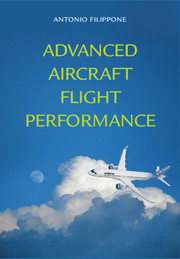Book contents
- Frontmatter
- Contents
- Tables
- Preface
- Nomenclature
- Technology Warning
- 1 Prolegomena
- 2 Aircraft Models
- 3 Weight and Balance Performance
- 4 Aerodynamic Performance
- 5 Engine Performance
- 6 Propeller Performance
- 7 Airplane Trim
- 8 Flight Envelopes
- 9 Take-Off and Field Performance
- 10 Climb Performance
- 11 Descent and Landing Performance
- 12 Cruise Performance
- 13 Manoeuvre Performance
- 14 Thermo-Structural Performance
- 15 Mission Analysis
- 16 Aircraft Noise: Noise Sources
- 17 Aircraft Noise: Propagation
- 18 Aircraft Noise: Flight Trajectories
- 19 Environmental Performance
- 20 Epilogue
- Appendix A Gulfstream G-550
- Appendix B Certified Aircraft Noise Data
- Appendix C Options for the FLIGHT Program
- Index
- References
9 - Take-Off and Field Performance
Published online by Cambridge University Press: 05 January 2013
- Frontmatter
- Contents
- Tables
- Preface
- Nomenclature
- Technology Warning
- 1 Prolegomena
- 2 Aircraft Models
- 3 Weight and Balance Performance
- 4 Aerodynamic Performance
- 5 Engine Performance
- 6 Propeller Performance
- 7 Airplane Trim
- 8 Flight Envelopes
- 9 Take-Off and Field Performance
- 10 Climb Performance
- 11 Descent and Landing Performance
- 12 Cruise Performance
- 13 Manoeuvre Performance
- 14 Thermo-Structural Performance
- 15 Mission Analysis
- 16 Aircraft Noise: Noise Sources
- 17 Aircraft Noise: Propagation
- 18 Aircraft Noise: Flight Trajectories
- 19 Environmental Performance
- 20 Epilogue
- Appendix A Gulfstream G-550
- Appendix B Certified Aircraft Noise Data
- Appendix C Options for the FLIGHT Program
- Index
- References
Summary
Overview
This chapter deals with a realistic model of the aircraft at take-off conditions. After an introduction to general take-off procedures, we deal with transport-type airplanes (§ 9.1) and write the general take-off equations (§ 9.2).We carry out numerical solutions with all-engines operating §9.3 and consider the case of one-engine inoperative, both accelerate-and-go and abort-and-stop (§ 9.4). The takeoff of a turboprop aircraft is solved in §9.5. Lateral control issues in both cases are dealt with in the analysis of the minimum control speed (§ 9.6). We discuss the important cases of aircraft braking (§ 9.7) and performance on contaminated runways (§ 9.8), including extreme cases such as hydroplaning and other forms of contamination. For the sake of completeness, we present more rapid closed-form solutions (§ 9.9). The chapter ends with considerations on field performance, including taxiing and turning (§ 9.10) and the effects of bird strike (§ 9.10.2).
KEY CONCEPTS: Take-Off Equations, Normal Take-Off, OEI Take-Off, Balanced Field Length, Decelerate-Stop, Accelerate-Go, Minimum Control Speed, Contaminated Runways, Ground Manoeuvring, Bird Strike.
Take-Off of Transport-Type Airplane
The take-off phase is dependent on a vast array of aircraft parameters and external circumstances – including the pilot's skills. Take-off lasts little time and burns a considerable amount of fuel.
There are several different types of aircraft take-off and landing. We will refer exclusively to Conventional Take-Off and Landing (CTOL). This class includes most civil, commercial and military vehicles, that is, subsonic jet transport, turboprop airplanes, and cargo airplanes that take off and land horizontally.
- Type
- Chapter
- Information
- Advanced Aircraft Flight Performance , pp. 224 - 268Publisher: Cambridge University PressPrint publication year: 2012
References
- 1
- Cited by



